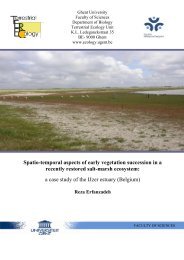PhD Arthur Decae 2010 - Ghent Ecology - Universiteit Gent
PhD Arthur Decae 2010 - Ghent Ecology - Universiteit Gent
PhD Arthur Decae 2010 - Ghent Ecology - Universiteit Gent
You also want an ePaper? Increase the reach of your titles
YUMPU automatically turns print PDFs into web optimized ePapers that Google loves.
39.539°N, 2.974°E, burrows in steep clay-bank along road between mixed forest and<br />
cultivated fields; 1 ♀ (AR14201), Randa, 39.531°N, 2.904°E, 8 April 1995, burrow in steep<br />
clay bank in garigue; 2 ♀♀ (9972.4012; 9972.4013), between Llucmajor and Porreres,<br />
39.503°N, 2.972°E, 5 April 1995 and 18 April 2002, burrows in steep roadside bank in mixed<br />
forest. All specimen leg. A. E. <strong>Decae</strong>.<br />
Etymology: The specific name is a noun in apposition taken from the geographical area, the<br />
Massis de Randa, where it was first discovered.<br />
Diagnosis: Nemesia randa differs from all other known Nemesia species, with the exception<br />
of N. bristowei, in the relatively large size and forward orientation of the ALE and the narrow<br />
clypeus (Fig. 36). It differs from N. bristowei by the larger size of adult female spiders and<br />
other characters mentioned in the diagnosis of N. bristowei. The male is unknown.<br />
Description: Female (holotype): BL = 20.6, CL = 7.6, CW = 6.0. Leg IV: T4> F4> M4. PSP:<br />
p = 2-2; I = 1-1; II = 1-1; III = 0-0; IV = 0-0. Dorsal aspect (Fig. 33). Carapace longer than<br />
wide, CL/CW=1.3, different shades of brown and yellow in suffused, indistinct pattern of<br />
darker central zones and lighter lateral zones, cervical grooves distinctly dark brown, setae in<br />
three longitudinal, somewhat irregular parallel rows, with strongest setae in central row and in<br />
small groups on ocular tubercle and along anterior edge of clypeus. Carapace indistinctly, but<br />
fully, covered with fine whitish pubescent hairs. Caput elevated, Ch/Th = 2.0. Clypeus<br />
narrow, Clyp = 0.12. Eye-group (Fig. 36) on steep ocular tubercle, less than twice as wide as<br />
long, AR/El = 1.69, anterior row slightly longer than posterior row, AR/ PR = 1.04, ALE<br />
orientated forward and much larger than other eyes, ALE/PLE = 1.57. POP unbroken. Fovea<br />
not smoothly recurved, but somewhat angular, dropping away from base of caput. Chelicerae<br />
dark chocolate brown, contrasting with yellowish carapace, broad glabrous zones between<br />
dorsal setae-field and lateral zones with fine hairs. Dorsal setae merging distally with field of<br />
stronger spines surrounding rastellum teeth. Cuticle of cheliceral furrow distinctly lighter in<br />
color, pro-margin of furrow with seven strong teeth, second and third (counting from fang<br />
base) largest, two proximals (6th and 7th) somewhat separated. Rastellum on small process<br />
distal and prolateral of fang base. Fangs rather short and blunt, with serrated keel (Fig. 7).<br />
Legs yellowish brown, slightly lighter than carapace; ventral and lateral surfaces of femora III<br />
and IV, ventral surfaces of patella I and tibiae I and II conspicuously lighter creamy white, all<br />
femora with dark central longitudinal zone dorsally. Scopulae strongly developed on tarsi and<br />
metatarsi I and II, extending slightly onto distal ends of tibiae I and II. Strong prolateral<br />
ventral spines in longitudinal rows on metatarsi and tibiae I and II, also more dorsally on<br />
metatarsus III, tibia III with two short prolateral spines (Fig. 37), spines on metatarsus and<br />
tibia IV thinner and fewer than on those segments of other legs. Slender spiny setae in<br />
longitudinal rows and distal groups dorsally on all femora. Metatarsus IV with retrolateral<br />
apical comb. Palp similar color to anterior legs, scopula on tarsus not extending onto tibia,<br />
one pro- and one retrolateral proximal spine on tarsus (left pro-lateral spine absent), fine<br />
ventral spines in tarsal scopula, rows of strong pro- and retrolateral spines on tibia, two<br />
prolateral spines on patella, a larger spine more ventrally and a smaller spine more dorsally<br />
placed, femur as legs. Ventral aspect (Fig. 34). Maxillae longer than wide (l/w = 1.8),<br />
extending into indistinct prolateral distal process, slightly darker than coxae and sternum,<br />
except for creamy white anterior zone of maxillary scopula. Ventrally evenly covered with<br />
setae; well developed row of cuspules along proximal margin. Sternum longer than wide (l/w<br />
= 1.2), widest between coxae II and III, yellow, evenly covered with fine setae of varying<br />
size, strongest setae along edges, three pairs of sigilla, anterior and median pairs touching<br />
margin, posterior pair more centrally placed (twice their diameter from sternum edge).<br />
Labium slightly darker than sternum, dome shaped, wider than long, evenly covered with<br />
setae. Labial furrow wide, glabrous, distinctly bicolored, yellowish along sternum, more<br />
greyish along labium. Abdomen greyish, evenly covered with fine setae, faint dorsal pattern<br />
of darker lines and chevrons. Spinnerets (Fig. 38) similar color to ventral abdomen; PMS










